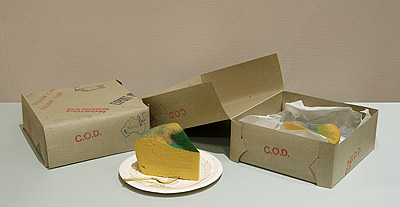Tony
COLEING
Australia
1942
England 1963-68; USA 1989
Yellow cake
1977
ceramic, metallic glitter, paper, plastic, tissue paper, cardboard, ink, photograph
1/1000
signed and dated on paper envelope, ink "you cant/ have your/ cake + eat/ it too/ T. Coleing/ 1977
10.0 (h)
x 25.2 (w)
x 25.5 (d)
cm
Gift of Ray Hughes 1981
National Gallery of Australia, Canberra
NGA 1981.17.A.A-I
© Tony Coleing
Yellow cake refers to uranium compounds used in the preparation of fuel for nuclear reactors. In Australia, mining for the metal oxide was a major political issue during the 1970s. Citizen and union groups lobbied government, citing environmental hazards and Aboriginal land rights as principal concerns. Public pressure culminated in 1977 with the Australian Labour Party and the Australian Council of Trade Unions opposing uranium mining. Coleing’s cakes, presented upon paper doilies inscribed with the message ‘you can’t have your cake and eat it too’, combine polystyrene foam and coloured metallic glitter. Appearing playfully edible―the artist provides us with spoons―the works hide a sinister message.
These two yellow cakes are from a larger series of works by the artist. In 1980 Coleing, Kevin Mortensen and Mike Parr represented Australia at the 39th Venice Biennale. In his installation Who wants to be a millionaire Coleing exhibited a large, single ’uranium’ cake that was then cut into 1000 slices and sold to visitors. Officials closed the performance after two days, stating Coleing contravened local law by selling ‘food’ in the Giardini precinct without an appropriate permit.[1] One may wonder, however, if the controversial nature of the work contributed to the early closure of the exhibit.
As Elwyn Lynn notes, Coleing’s cakes ‘may appear simple, even amateurish and unsophisticated, but a deal of calculation lies behind his use of the most banal (seemingly) images to hand; again, serious as he may be, he cannot avoid an ironic and biting humour.’[2] The combination of form, colour, material and text reinforces Coleing’s sculptural pun, while urging reconsideration of nuclear power as a viable energy source.
Lisa McDonald
International Art
National Gallery of Australia, Canberra
[1] Coleing exhibited two other works at the Australian Pavilion: An Australian native plantation which consisted of statues of Aboriginals and koalas, and A great Australian bite, in which viewers were able to purchase small Vegemite sandwiches
[2] Elwyn Lynn, Venice Biennale 1980 Australia, Visual Arts Board of the Australia Council, Sydney, 1980, p 5. Lynn served as Chairman of the Visual Arts Board between 1976 and 1980

